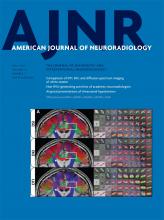Index by author
Kallas, O.
- Adult BrainOpen AccessEvaluating Permeability Surface-Area Product as a Measure of Blood-Brain Barrier Permeability in a Murine ModelE.K. Weidman, C.P. Foley, O. Kallas, J.P. Dyke, A. Gupta, A.E. Giambrone, J. Ivanidze, H. Baradaran, D.J. Ballon and P.C. SanelliAmerican Journal of Neuroradiology July 2016, 37 (7) 1267-1274; DOI: https://doi.org/10.3174/ajnr.A4712
Karikari, I.O.
- Spine Imaging and Spine Image-Guided InterventionsYou have accessThe “Hyperdense Paraspinal Vein” Sign: A Marker of CSF-Venous FistulaP.G. Kranz, T.J. Amrhein, W.I. Schievink, I.O. Karikari and L. GrayAmerican Journal of Neuroradiology July 2016, 37 (7) 1379-1381; DOI: https://doi.org/10.3174/ajnr.A4682
Katorza, E.
- Pediatric NeuroimagingYou have accessDevelopment of the Fetal Vermis: New Biometry Reference Data and Comparison of 3 Diagnostic Modalities–3D Ultrasound, 2D Ultrasound, and MR ImagingE. Katorza, E. Bertucci, S. Perlman, S. Taschini, R. Ber, Y. Gilboa, V. Mazza and R. AchironAmerican Journal of Neuroradiology July 2016, 37 (7) 1359-1366; DOI: https://doi.org/10.3174/ajnr.A4725
Kaufman, R.A.
- FELLOWS' JOURNAL CLUBPediatric NeuroimagingOpen AccessFull Dose-Reduction Potential of Statistical Iterative Reconstruction for Head CT Protocols in a Predominantly Pediatric PopulationA.E. Mirro, S.L. Brady and R.A. KaufmanAmerican Journal of Neuroradiology July 2016, 37 (7) 1199-1205; DOI: https://doi.org/10.3174/ajnr.A4754
The authors set out to determine the maximum level of statistical iterative reconstruction that can be used to establish dose-reduced head CT protocols in a primarily pediatric population while maintaining similar appearance and level of image noise in the reconstructed image. Dose-reduced head protocols using an adaptive statistical iterative reconstruction were compared for image quality with the original filtered back-projection reconstructed protocols in a phantom and CT dose index and image noise magnitude were assessed in 737 pre- and post-dose-reduced examinations. Implementation of 40% and 60% adaptive statistical iterative reconstruction led to an average reduction in the volume CT dose index of 43% for brain, 41% for orbit, 30% for maxilla, 43% for sinus, and 42% for temporal bone protocols for patients between 1 month and 26 years of age, while improving the contrast-to-noise ratio of low-contrast soft-tissue targets.
Khanna, O.
- Adult BrainOpen AccessQuantitative Susceptibility Mapping in Cerebral Cavernous Malformations: Clinical CorrelationsH. Tan, L. Zhang, A.G. Mikati, R. Girard, O. Khanna, M.D. Fam, T. Liu, Y. Wang, R.R. Edelman, G. Christoforidis and I.A. AwadAmerican Journal of Neuroradiology July 2016, 37 (7) 1209-1215; DOI: https://doi.org/10.3174/ajnr.A4724
Kim, J.
- FELLOWS' JOURNAL CLUBAdult BrainYou have accessAtypical Presentations of Intracranial Hypotension: Comparison with Classic Spontaneous Intracranial HypotensionA.A. Capizzano, L. Lai, J. Kim, M. Rizzo, L. Gray, M.K. Smoot and T. MoritaniAmerican Journal of Neuroradiology July 2016, 37 (7) 1256-1261; DOI: https://doi.org/10.3174/ajnr.A4706
The authors evaluated the clinical records and neuroimaging of patients with spontaneous intracranial hypotension from September 2005 to August 2014. Patients with classic spontaneous intracranial hypotension (n = 33) were compared with those with intracranial hypotension with atypical clinical presentation (n = 8). There was no significant difference in dural enhancement, subdural hematomas, or cerebellar tonsil herniation. Patients with atypical spontaneous intracranial hypotension had significantly more elongated anteroposterior midbrain diameter compared with those with classic spontaneous intracranial hypotension, and shortened pontomammillary distance. In this population, patients with atypical spontaneous intracranial hypotension showed a more chronic syndrome compared with classic spontaneous intracranial hypotension, more severe brain sagging, lower rates of clinical response, and frequent relapses.
Kister, I.
- EDITOR'S CHOICEAdult BrainOpen AccessIron and Non-Iron-Related Characteristics of Multiple Sclerosis and Neuromyelitis Optica Lesions at 7T MRIS. Chawla, I. Kister, J. Wuerfel, J.-C. Brisset, S. Liu, T. Sinnecker, P. Dusek, E.M. Haacke, F. Paul and Y. GeAmerican Journal of Neuroradiology July 2016, 37 (7) 1223-1230; DOI: https://doi.org/10.3174/ajnr.A4729
Twenty-one patients with MS and 21 patients with neuromyelitis optica underwent 7T high-resolution 2D-gradient-echo-T2* and 3D-susceptibility-weighted imaging. An in-house-developed algorithm was used to reconstruct quantitative susceptibility mapping from SWI. Of the patients with MS, 19 (90.5%) demonstrated at least 1 quantitative susceptibility mapping–hyperintense lesion, and 11/21 (52.4%) had iron-laden lesions. No quantitative susceptibility mapping–hyperintense or iron-laden lesions were observed in any patients with neuromyelitis optica. The authors conclude that ultra-high-field MR imaging may be useful in distinguishing MS from neuromyelitis optica.
Kitabayashi, T.
- NeurointerventionYou have accessInflow Jet Patterns of Unruptured Cerebral Aneurysms Based on the Flow Velocity in the Parent Artery: Evaluation Using 4D Flow MRIK. Futami, T. Kitabayashi, H. Sano, K. Misaki, N. Uchiyama, F. Ueda and M. NakadaAmerican Journal of Neuroradiology July 2016, 37 (7) 1318-1323; DOI: https://doi.org/10.3174/ajnr.A4704
Kleinloog, R.
- NeurointerventionOpen AccessThinner Regions of Intracranial Aneurysm Wall Correlate with Regions of Higher Wall Shear Stress: A 7T MRI StudyR. Blankena, R. Kleinloog, B.H. Verweij, P. van Ooij, B. ten Haken, P.R. Luijten, G.J.E. Rinkel and J.J.M. ZwanenburgAmerican Journal of Neuroradiology July 2016, 37 (7) 1310-1317; DOI: https://doi.org/10.3174/ajnr.A4734
Kranz, P.G.
- Spine Imaging and Spine Image-Guided InterventionsYou have accessThe “Hyperdense Paraspinal Vein” Sign: A Marker of CSF-Venous FistulaP.G. Kranz, T.J. Amrhein, W.I. Schievink, I.O. Karikari and L. GrayAmerican Journal of Neuroradiology July 2016, 37 (7) 1379-1381; DOI: https://doi.org/10.3174/ajnr.A4682
- Spine Imaging and Spine Image-Guided InterventionsYou have accessImaging Signs in Spontaneous Intracranial Hypotension: Prevalence and Relationship to CSF PressureP.G. Kranz, T.P. Tanpitukpongse, K.R. Choudhury, T.J. Amrhein and L. GrayAmerican Journal of Neuroradiology July 2016, 37 (7) 1374-1378; DOI: https://doi.org/10.3174/ajnr.A4689








